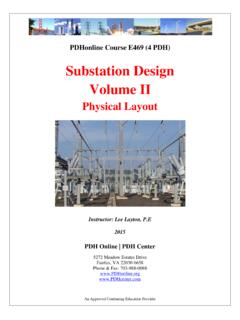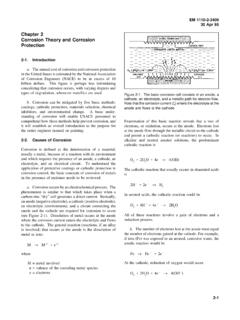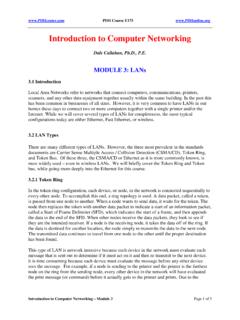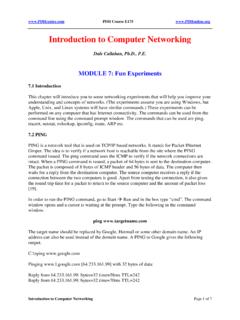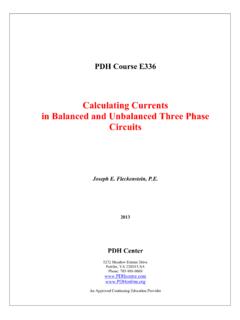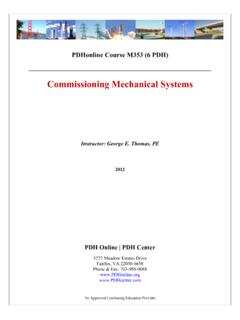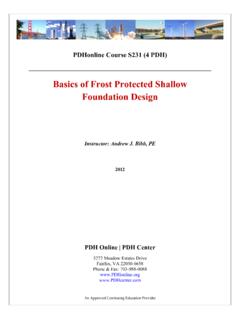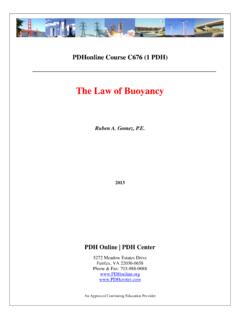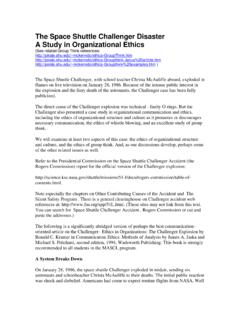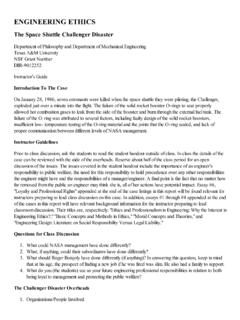Transcription of Engineering Ethics Case Study: The Challenger Disaster
1 PDHonline Course R143 (3 PDH) Engineering Ethics Case Study: TheChallenger Disaster2012 Instructor: Mark P. Rossow, , PE RetiredPDH Online | PDH Center5272 Meadow Estates DriveFairfax, VA 22030-6658 Phone & Fax: Approved Continuing Education ProviderThe Challenger Disaster and Engineering Ethics Mark P. Rossow PE, PhD Emeritus Professor of Civil Engineering Southern Illinois University Edwardsville 2 2012 Mark P. Rossow Also published as The Challenger Disaster and Engineering Ethics Kindle Edition All rights reserved. No part of this work may be reproduced in any manner without the written permission of the author. The cover image is part of the collection: NASA Images. From the description given on the website: Close-up view of the liftoff of the shuttle Challenger on mission STS-51L taken from camera site 39B-2/T3. From this camera position, a cloud of grey-brown smoke can be seen on the right side of the Solid Rocket Booster (SRB) on a line directly across from the letter "U" in United States.
2 This was the first visible sign that an SRB joint breach may have occurred. On January 28, 1986 frigid overnight temperatures caused normally pliable rubber O-ring seals and putty that are designed to seal and establish joint integrity between the Solid Rocket Booster (SRB) joint segments, to become hard and non- flexible. At the instant of SRB ignition, tremendous stresses and pressures occur within the SRB casing and especially at the joint attachment points. The failure of the O-rings and putty to "seat" properly at motor ignition, caused hot exhaust gases to blow by the seals and putty. During Challenger 's ascent, this hot gas "blow by" ultimately cut a swath completely through the steel booster casing; and like a welder's torch, began cutting into the External Tank (ET). It is believed that the ET was compromised in several locations starting in the aft at the initial point where SRB joint failure occurred.
3 The ET hydrogen tank is believed to have been breached first, with continuous rapid incremental failure of both the ET and SRB. A chain reaction of events occurring in milliseconds culminated in a massive explosion. The orbiter Challenger was instantly ejected by the blast and went askew into the supersonic air flow. These aerodynamic forces caused structural shattering and complete destruction of the orbiter. Though it was concluded that the G-forces experienced during orbiter ejection and break-up were survivable, impact with the ocean surface was not. Tragically, all seven crewmembers perished. 3 Preface This book presents an explanation for the Space shuttle Challenger Disaster that differs significantly from conventional explanations. The book is intended for three audiences: 1) students in Engineering Ethics classes, 2) practicing engineers concerned about professional Ethics issues, and 3) laypersons interested in gaining a more accurate picture of one of the most publicized and misunderstood technological disasters of the twentieth century.
4 After the Disaster occurred, a presidential commission investigated the causes and produced a report, Report to the President by the Presidential Commission on the Space shuttle Challenger Accident1, which was very influential in creating the conventional explanation of the Disaster . Much more complete accounts of events leading up to the Disaster were given in books by the sociologist, Diane Vaughan, in The Challenger Launch Decision2, and by the historians, Andrew Dunar and Stephen Waring, in Power To Explore -- History of Marshall Space Flight Center 1960-19903. As Dunar and Waring put it and their remarks apply to Vaughan s work as well Allowing Marshall engineers and managers to tell their story, based on pre-accident documents and on post-accident testimony and interviews, leads to a more realistic account of the events leading up to the accident than that found in the previous studies. I would strongly encourage anyone with the time and interest to read both of these books, which are outstanding works of scholarship (Besides conducting her own interviews, Vaughan made use of transcripts from 160 interviews more than 9,000 pages conducted by government investigators4).
5 For those persons lacking the time the Vaughan book is over 550 pages I have written the present condensed description of the Challenger incident. I have drawn the material for Sections 1-8, 10 and 13 from multiple sources but primarily from Vaughan, the Report to the President, and Dunar and Waring. Of course, any errors introduced during the process of fitting their descriptions and ideas into my narrative are mine and not the fault of these authors. Sections 9, 11, and 12 are original contributions of my own. All figures have been taken from Report to the President. I would like to thank Molly Rossow for reviewing an early draft of the text and suggesting improvements. Mark P. Rossow 4 Contents Introduction .. 5 1. Two Common Errors of Interpretation .. 5 2. Configuration of shuttle .. 7 3. Function of O-rings .. 10 4. History of Problems with Joint Seals .. 13 5. Teleconference .. 15 6. Accident.
6 18 7. Ethical issue: Did NASA knowingly take extra risks because of pressure to maintain Congressional funding? .. 30 8. Ethical issue: Did Thiokol knowingly take extra risks because of fear of losing its contract with NASA? .. 31 9. Ethical issue: Was the Principle of Informed Consent Violated? .. 32 10. Ethical issue: What role did whistle blowing have in the Challenger story?.. 33 11. Ethical issue: Who had the right to Thiokol documents relating to the Challenger Disaster ? 34 12. Ethical issue: Why are some Engineering disasters considered ethical issues and others are not? .. 34 13. Concluding remarks .. 36 Glossary .. 36 Notes .. 37 About the Author .. 40 5 Introduction On January 28, 1986, the NASA Space shuttle Challenger burst into a ball of flame 73 seconds after take-off, leading to the death of all seven people on board. Some months later, a commission appointed by the President to investigate the Disaster declared, in the Report to the President by the Presidential Commission on the Space shuttle Challenger Accident,1 that the cause was the failure of a seal in one of the solid rocket boosters5.
7 The commission also said that even though the seals had been recognized as a potential hazard for several years prior to the Disaster , management had failed to fix the problem because of a lack of communication between engineers and management and because of poor management practices. Furthermore, the news came out that Morton Thiokol, the contractor responsible for the seal design, had initiated a teleconference with NASA on the evening before the launch and had, at the beginning of the teleconference, recommended against launching because of concerns about the seal. This recommendation was then reversed during the teleconference, with fatal consequences. The commission and many other commentators used the reversal of the recommendation to support accusations of managerial wrongdoing. These observations and accusations taken together became the standard interpretation of the cause of the Challenger Disaster .
8 This interpretation routinely appears in popular articles and books about Engineering , management, and ethical issues when Challenger is cited as a case study. But the interpretation ignores much of the history of how NASA and the contractor s engineers had actually recognized and dealt with the seal problems in advance of the Disaster . When this history is considered in more detail, the conclusions of the Report to the President become far less convincing. This book begins by presenting the minimum technical details needed to understand the physical cause of the shuttle failure. The failure itself is illustrated through NASA photographs. Next the decision-making process especially the discussions occurring during the teleconference held on the evening before the launch is described. Direct quotations from engineers interviewed after the Disaster are used to illustrate the ambiguities of the data and the pressures that the decision-makers faced in the period preceding the launch.
9 The book ends by presenting six ethical issues raised by Challenger . A primary goal of the book is to demonstrate that issues that had appeared simple initially are actually far more complex; pinpointing responsibility and assigning blame are not nearly as easy as many popular accounts have made them. 1. Two Common Errors of Interpretation Persons studying the history of an Engineering Disaster must be alert to the danger of committing one of the following common errors: 1) the myth of perfect Engineering practice, and 2) the retrospective fallacy. The Myth of Perfect Engineering Practice The sociologist, Diane Vaughan, who has written one of the most thorough books on Challenger , has pointed out that the mere act of investigating an accident can cause us to view, as ominous, facts and events that we otherwise would consider normal: When technical systems fail, .. outside investigators consistently find an Engineering world characterized by ambiguity, 6 disagreement, deviation from design specifications and operating standards, and ad hoc rule making.
10 This messy situation, when revealed to the public, automatically becomes an explanation for the failure, for after all, the engineers and managers did not follow the rules.. [On the other hand,] the Engineering process behind a nonaccident is never publicly examined. If nonaccidents were investigated, the public would discover that the messy interior of Engineering practice, which after an accident investigation looks like an accident waiting to happen, is nothing more or less than normal technology. 6 Thus as you read the description of the Challenger Disaster on the pages to follow, keep in mind that just because some of the Engineering practices described are not neat and tidy processes in which consensus is always achieved and decisions are always based on undisputed and unambiguous data, that fact alone may not explain the Disaster ; such practices may simply be part of normal technology that usually results in a nonaccident.
